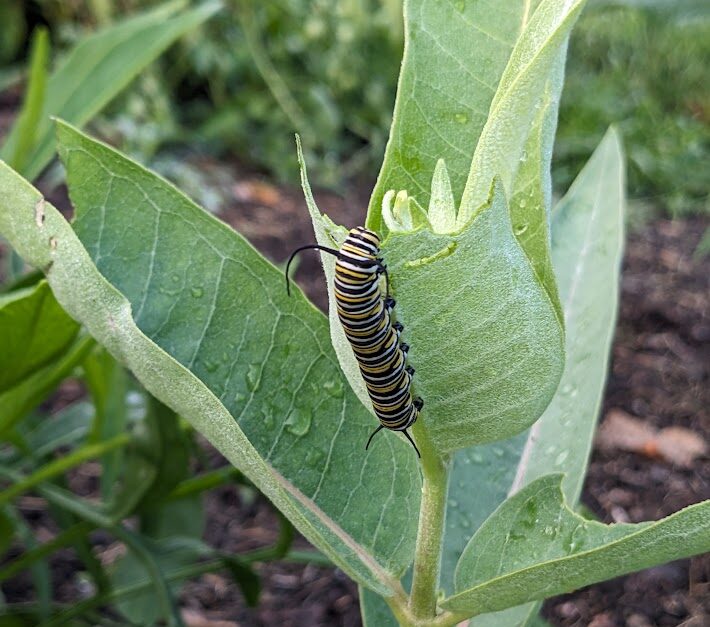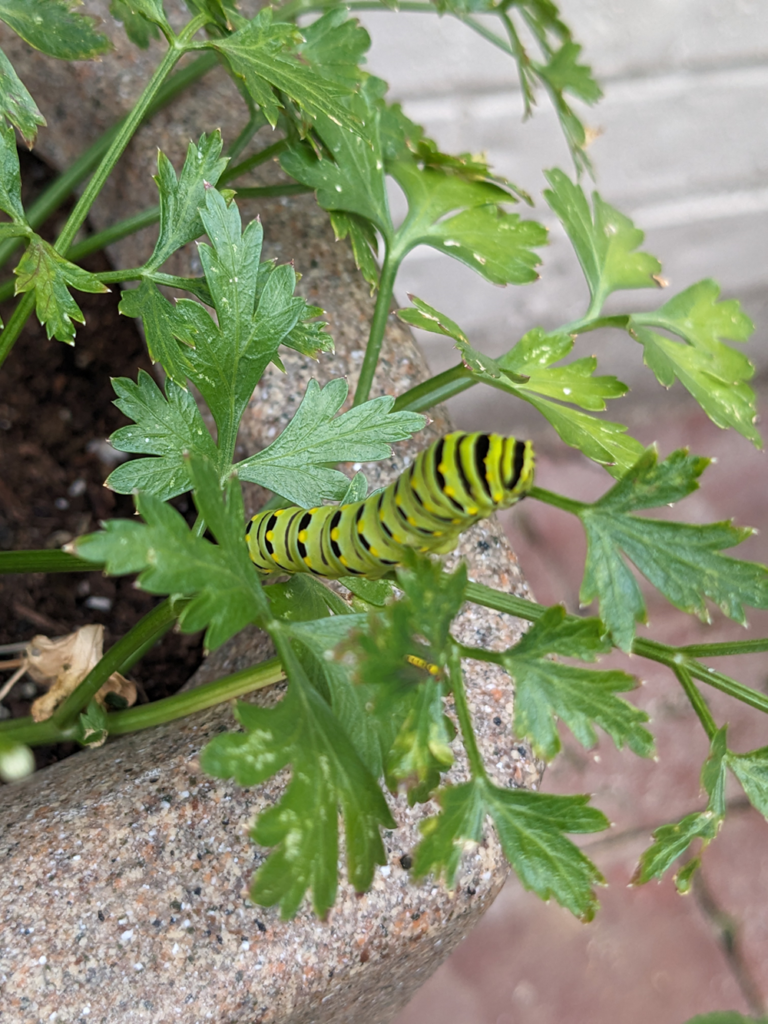
All plants have some baseline ecological benefits. They prevent erosion, keep moisture and nutrients in the soil, and sequester carbon. They also provide shade, shelter, and cover for species ranging from tiny insects to large mammals.
But when we talk about the most beneficial plants and trees to plant (or conserve) in a given area, that typically means species that also provide food for a similarly wide range of species.
Larger mammals like deer and rabbits can famously turn almost anything in a garden into food, but at the lower levels of the food chain, many of these are specialist interactions that only certain plants can provide.
One example of this is the monarch butterfly whose caterpillars can only feed on milkweed leaves, making the presence of milkweed a requirement for monarchs to be able to complete their life cycle.
Caterpillars, it turns out, are an especially important group to support. They of course turn into the pollinators that are so important for our flowering plants, but they also themselves a crucial food source for larger animals, including one group that is another of the most popular for gardeners to try to attract: birds.
Birds of course do snack on the seeds we put in our feeders, but for many species of native birds, caterpillars, and lots of them, are required for nestlings to survive. Doug Tallamy explains that “caterpillars are highly nutritious, providing an essential source of protein and fats needed for the rapid growth and development of young birds.”
And although larger caterpillars that turn into our favorite butterflies, like monarchs, are at the forefront of most people’s minds when they think of these relationships, it’s smaller and less conspicuous moths are often an even more important part of the ecological puzzle: “North America is home to more than 12,000 species—an astonishing number compared to our relatively paltry 800 or so species of butterflies!” Adult moths often only live for a few days, and many species are most active at night where they’re less obvious, but behind the scenes they are playing a crucial ecological role that you can directly impact by planting host plants.
As Jim McCormac explains, “nearly all of our songbirds seek out moth caterpillars, and many species eat them in enormous quantities. The caterpillar eaters include chickadees, cuckoos, kinglets, vireos, warblers, wrens and many others. Even normally vegan sparrows harvest caterpillars to feed nestlings.”
And the numbers of caterpillars needed to sustain these larger animals (with enough left over to pollinate and serve their other important roles) is huge. One study found that “one chickadee family fed their babies 350 to 570 caterpillars every day. That’s 6,000 to 9,000 caterpillars to raise one family of baby birds.”
Because of these numbers, gardening for butterflies means you need to create the conditions for a lot of
Forgetting Larval Host Plants: A Common Butterfly Gardening Mistake
With this understanding of the crucial role of lepidoptera (butterfly and moth) caterpillars in the food chain, we can return to the idea of gardening for butterflies and see how host plants are a necessity, even when they aren’t always prioritized.
When you see plants being advertised as pollinator favorites or good for a butterfly garden, this often is referring to the nectar that the adults feed on.
And this can encompass a huge range of plants, both native and nonnative, and even some invasive plants, which can give butterflies a bit of food in the short-term but overall cause more harm than good.
But even setting aside invasives, any nectar source that the caterpillars of those butterflies and moths cannot feed on means a failure to complete the life cycle and the end of the line for those pollinators.
Only if they find one of their host plants will they be able to lay their eggs there and the larvae have a food source to sustain them as soon as they hatch.
Effective butterfly gardening, then, goes beyond just providing colorful flowers and nectar and needs to take into account whether the next generation will be able to feed on the leaves or not.
Can Nonnative Plants Be Larval Host Plants?
Each species of lepidoptera has its own host plants including perennials, shrubs, and trees and it can vary significantly how many there are in total. Milkweed (asclepias) and monarchs are on one side of the spectrum as a sole genus that can serve as a host plant.
Other butterfly and moth caterpillars can host on a variety of plants, often including native trees and shrubs that have this relationship with a wide variety of lepidoptera. The best plants for many species are known as keystones, and oak, birch, plum/cherry, maple, and willow trees are for most areas in the United States the genera that “host the most,” while for flowering perennials it is usually goldenrod, aster, and native sunflowers at the top of the list.)
These plant-caterpillar relationships most typically involve plants that are native to the same area as the insect, which makes sense when we think of it in terms of their co-evolution together. But this isn’t always the case. Swallowtails, for one, can successfully feed on many nonnative herbs and vegetables.
Other low-growing nonnative plants that can still host a variety of caterpillars include clover, dandelion, and dock.

But despite these cases, it’s undoubtedly the case that native plants play a massive role in these relationships and are incredibly important for maintaining healthy populations of pollinators including butterflies.
And often we’re still discovering some of these symbiotic relationships, as one native plant gardener put it: “There’s hundreds of animals, thousands of bugs, and untold numbers of different microbes, and any of them could have specific interactions that only native plants can provide.”
So if you want butterflies in your own garden, it’s a great idea to research some of the best host plants for your area, so you can support the ecosystem and all the wildlife that depends on them, generation after generation.
Leave a Reply